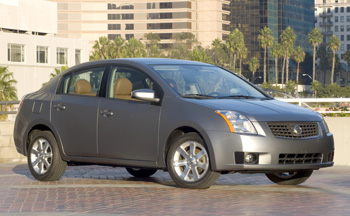
PEBBLE BEACH, CA – Without badging, casual observers would be hard-pressed to guess the car being test-driven here in mid-August hails from Nissan Motor Co. Ltd.
Isn’t this the auto maker that clawed its way back to profitability and acclaim with bold, eye-catching styling, evident on the current-generation Altima and Infiniti G35?
Shiro Nakamura, Nissan’s global design chief who has risen to rock-star status in the auto industry, eschews the angular design language taking hold these days. He prefers sinuous, graceful lines.
But the rounded, jellybean-like styling of the new, sixth-generation Nissan Sentra, developed exclusively for North America, dates the car before it even goes on sale.
The first version of the redesigned Sentra tested badly a few years ago with consumers, who considered it over-styled. The vehicle was delayed as designers went back to the studio. Perhaps the resulting model arriving in showrooms goes too far into the “safe” realm.
Although not much to look at, the new Sentra’s power and appointments represent a significant upgrade over the current Sentra, which is way past its sell-by date, having been available in its present form for nearly a decade.
Powered by Nissan’s 2L 4-cyl. MR series engine, the ’07 Sentra’s horsepower is boosted from 126 with the outgoing 1.8L to 140 hp, reached at 5,100 rpm vs. 6,000 rpm in the out-going model.

Torque is up as well, to 147 lb.-ft. (199 Nm) from 129 lb.-ft. (175 Nm) with the old 1.8L. Peak torque is not reached with the new 2L until 4,800 rpm, up significantly from 2,400 rpm with the 1.8L. Nissan says 90% of the torque is achieved by 2,400 rpm with the new mill.
However, the engine does seem to strain under hard acceleration, and there is a bit of hesitation in models equipped with a continuously variable transmission vs. those with the standard 6-speed manual.
The manual gearbox is the same unit used in the Nissan Versa subcompact and shifts smoothly, more so than in the Versa.
But for the most part, the CVT, which Nissan expects to be the more popular transmission, is quite good and goes about its business without the typical “winding up” associated with CVTs.
This is likely due to new programming of the shift controller, which Nissan says boosts shift speed response 30% and reduces internal friction by the same amount.
Switching to a CVT from the fifth-generation Sentra’s 4-speed automatic provides a fuel economy increase of 1 mpg (0.4 km/L) city and 2 mpg (0.8 km/L) highway. The new Sentra is rated at 29 mpg city (8 L/100km) and 36 mpg highway (7 L/100km).
The vehicle’s standard electric power steering feels nicely weighted, requiring light effort at low speeds and slightly more effort at higher speeds. Nissan says the EPS increases fuel economy 1.5% by eliminating the hydraulic pump that saps energy from the engine in conventional power steering systems.
Sentra’s suspension features independent struts up front and a torsion beam-type setup in the rear.
A new platform, the Renault SA-Nissan Alliance’s global C architecture, allows for the separation of the coil spring from the shock in the rear, increasing trunk capacity to 13.1 cu.-ft. (370 L).

The flatter packaging allows for a patent-pending dual trunk system Nissan calls “Divide-N-Hide,” which uses a removable divider for two separate storage compartments.
Other interior innovations include a removable 8-disc CD holder that is mounted on the headliner behind the driver’s visor – handy for keeping discs from cooking in the sun on hot days.
Front cupholders are configurable, with a sliding mechanism to accommodate 32-oz. (1L) beverages, as well as CDs and DVDs.
A 60/40 split rear seat folds flat, after the bottom cushion is folded up, to create a spacious load floor. Rear head restraints articulate forward and flip upright with the bop of a hand.
Overall, Sentra’s interior look is clean, and materials appear to be of high quality.
Three Sentra trims will be offered: 2.0, 2.0 S and 2.0 SL. Standard features on the base package include air conditioning and power windows and door locks. Prices are expected to begin at about $15,000.
The top-of-the-line 2.0 SL model includes the CVT transmission (optional on other packages), leather trim, keyless entry and keyless ignition, Bluetooth connectivity and antilock brakes.
Although ABS is standard on other vehicles in the class, specifically the Honda Civic, Nissan says buyers would rather have standard comfort and convenience features. ABS is optional on the other trims.
Nissan’s Aguascalientes, Mexico, plant has capacity to build 350,000 Sentras annually. The auto maker, while skittish about U.S. sales goals, says it wants to maintain or surpass the outgoing model’s annual U.S. sales level of 120,000 units.
Nissan aims the vehicle at “Echo Boomers,” born between 1977 and 1996.
Whether the dull outward appearance registers with that demographic remains to be seen. The current model’s average owner is a woman in her 40s.
The new Sentra goes on sale this month in the U.S.



